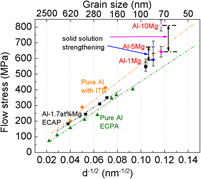Crossref Citations
This article has been cited by the following publications. This list is generated based on data provided by
Crossref.
Fan, Cuncai
Xie, Dongyue
Li, Jin
Shang, Zhongxia
Chen, Youxing
Xue, Sichuang
Wang, Jian
Li, Meimei
El-Azab, Anter
Wang, Haiyan
and
Zhang, Xinghang
2019.
9R phase enabled superior radiation stability of nanotwinned Cu alloys via in situ radiation at elevated temperature.
Acta Materialia,
Vol. 167,
Issue. ,
p.
248.
Li, Qiang
Xue, Sichuang
Zhang, Yifan
Sun, Xing
Wang, Haiyan
and
Zhang, Xinghang
2020.
Plastic anisotropy and tension-compression asymmetry in nanotwinned Al–Fe alloys: An in-situ micromechanical investigation.
International Journal of Plasticity,
Vol. 132,
Issue. ,
p.
102760.
Roy, Abir
Tiwari, Manish
Sahu, Sandeep
Mishra, Sumeet
and
Kumar, Abhishek
2020.
Microstructure, Texture and Mechanical Properties of Al-Mg-Si Alloy Processed by Multiaxial Compression.
Journal of Materials Engineering and Performance,
Vol. 29,
Issue. 6,
p.
3876.
Li, Qiang
Xie, Dongyue
Shang, Zhongxia
Sun, Xing
Cho, Jaehun
Zhang, Yifan
Xue, Sichuang
Wang, Haiyan
Wang, Jian
and
Zhang, Xinghang
2020.
Coupled solute effects enable anomalous high-temperature strength and stability in nanotwinned Al alloys.
Acta Materialia,
Vol. 200,
Issue. ,
p.
378.
Zhang, Y. F.
Su, R.
Xie, D. Y.
Niu, T. J.
Xue, S.
Li, Q.
Shang, Z.
Ding, J.
Richter, N. A.
Wang, Jian
Wang, H.
and
Zhang, X.
2020.
Design of super-strong and thermally stable nanotwinned Al alloys via solute synergy.
Nanoscale,
Vol. 12,
Issue. 39,
p.
20491.
Zhang, Y.F.
Li, Qiang
Gong, M.
Xue, S.
Ding, J.
Li, Jin
Cho, J.
Niu, T.
Su, Ruizhe
Richter, N.A.
Wang, H.
Wang, J.
and
Zhang, X.
2020.
Deformation behavior and phase transformation of nanotwinned Al/Ti multilayers.
Applied Surface Science,
Vol. 527,
Issue. ,
p.
146776.
Li, Qiang
Xue, Sichuang
Fan, Cuncai
Richter, Nicholas A.
Zhang, Yifan
Chen, Youxing
Wang, Haiyan
and
Zhang, Xinghang
2021.
Epitaxial nanotwinned metals and alloys: synthesis-twin structure–property relations.
CrystEngComm,
Vol. 23,
Issue. 38,
p.
6637.
Lei, Tianjiao
Shin, Jungho
Gianola, Daniel S.
and
Rupert, Timothy J.
2021.
Bulk nanocrystalline Al alloys with hierarchical reinforcement structures via grain boundary segregation and complexion formation.
Acta Materialia,
Vol. 221,
Issue. ,
p.
117394.
Ding, Jie
Xue, S.
Shang, Z.
Li, Jin
Zhang, Y.
Su, R.
Niu, T.
Wang, H.
and
Zhang, X.
2021.
Characterization of precipitation in gradient Inconel 718 superalloy.
Materials Science and Engineering: A,
Vol. 804,
Issue. ,
p.
140718.
Gong, Mingyu
Wu, Wenqian
Xie, Dongyue
Richter, Nicholas A.
Li, Qiang
Zhang, Yifan
Xue, Sichuang
Zhang, Xinghang
and
Wang, Jian
2021.
First-principles calculations for understanding microstructures and mechanical properties of co-sputtered Al alloys.
Nanoscale,
Vol. 13,
Issue. 35,
p.
14987.
Yang, Bo
Shang, Z.
Ding, Jie
Lopez, Jack
Jarosinski, William
Sun, T.
Richter, N.
Zhang, Y.
Wang, H.
and
Zhang, X.
2022.
Investigation of strengthening mechanisms in an additively manufactured Haynes 230 alloy.
Acta Materialia,
Vol. 222,
Issue. ,
p.
117404.
Li, Qiang
Wang, Jian
Wang, Haiyan
and
Zhang, Xinghang
2022.
Achieving strong and stable nanocrystalline Al alloys through compositional design.
Journal of Materials Research,
Vol. 37,
Issue. 1,
p.
183.
Sheng, X. Y.
Richter, N. A.
Shang, A. Y.
Wang, H.
and
Zhang, X.
2023.
Twin density and twin thickness evolution in sputtered Al–Mg alloys.
Journal of Applied Physics,
Vol. 133,
Issue. 20,
Zhang, Jingfan
Zhou, Dengshan
Pang, Xueyong
Zhang, Bowen
Li, Yue
Sun, Binhan
Valiev, Ruslan Z.
and
Zhang, Deliang
2023.
Deformation-induced concurrent formation of 9R phase and twins in a nanograined aluminum alloy.
Acta Materialia,
Vol. 244,
Issue. ,
p.
118540.
Sheng, X.Y.
Shang, Z.
Shang, A.Y.
Wang, H.
and
Zhang, X.
2024.
Grain boundary and twin boundary solute segregations in nanocrystalline Al-Mg alloy.
Scripta Materialia,
Vol. 245,
Issue. ,
p.
116053.
Song, Chang-Rong
Zhang, Si-Yu
Liu, Lin
Yang, Hong-Yu
Kang, Jie
Meng, Jia
Luo, Chang-Jie
Wang, Cheng-Gang
Cao, Kuang
Qiao, Jian
Shu, Shi-Li
Zhu, Ming
Qiu, Feng
and
Jiang, Qi-Chuan
2024.
Research Progress on the Microstructure Evolution Mechanisms of Al-Mg Alloys by Severe Plastic Deformation.
Materials,
Vol. 17,
Issue. 17,
p.
4235.
KRÁLÍK, Rostislav
KŘIVSKÁ, Barbora
BAJTOŠOVÁ, Lucia
STOLBCHENKO, Mykhailo
SCHAPER, Mirko
GRYDIN, Olexandr
and
CIESLAR, Miroslav
2024.
Effect of Sc addition on downstream processing of twin-roll cast Al−Cu−Li−Mg−Zr-based alloys.
Transactions of Nonferrous Metals Society of China,
Vol. 34,
Issue. 6,
p.
1759.
Zhang, Jingfan
Zhang, Xiuzhen
Wei, Shaolou
Chen, Xinren
Pan, Shuaihang
Yang, Chao
Pan, Hucheng
Zhou, Dengshan
Zhang, Deliang
and
Qin, Gaowu
2025.
Deformation faulting in ultrafine-grained aluminum alloys: Nucleation mechanisms and critical assessment of strengthening-ductilization contributions.
Acta Materialia,
Vol. 286,
Issue. ,
p.
120750.
Sheng, X.Y.
Shang, Z.X.
Zhang, Y.F.
Xu, K.
Richter, N.A.
Shang, A.Y.
Wang, H.
and
Zhang, X.
2025.
Ultra-high strength, deformable nanocrystalline Al-Pd alloys.
International Journal of Plasticity,
Vol. 189,
Issue. ,
p.
104330.
